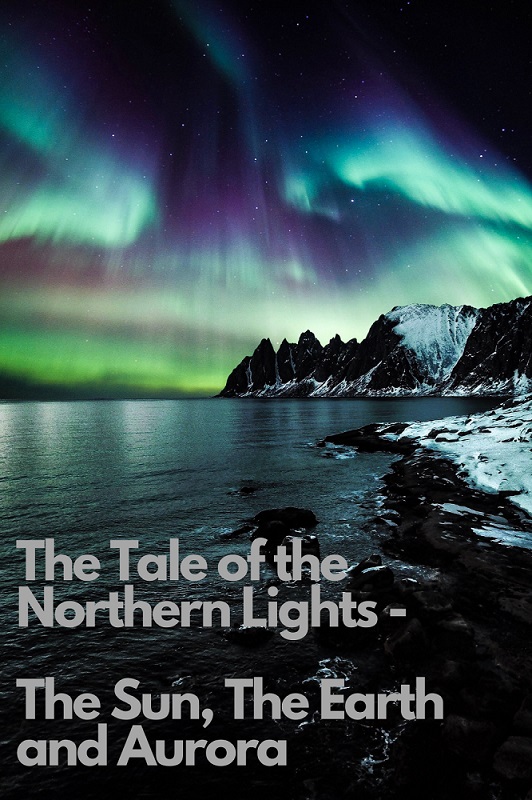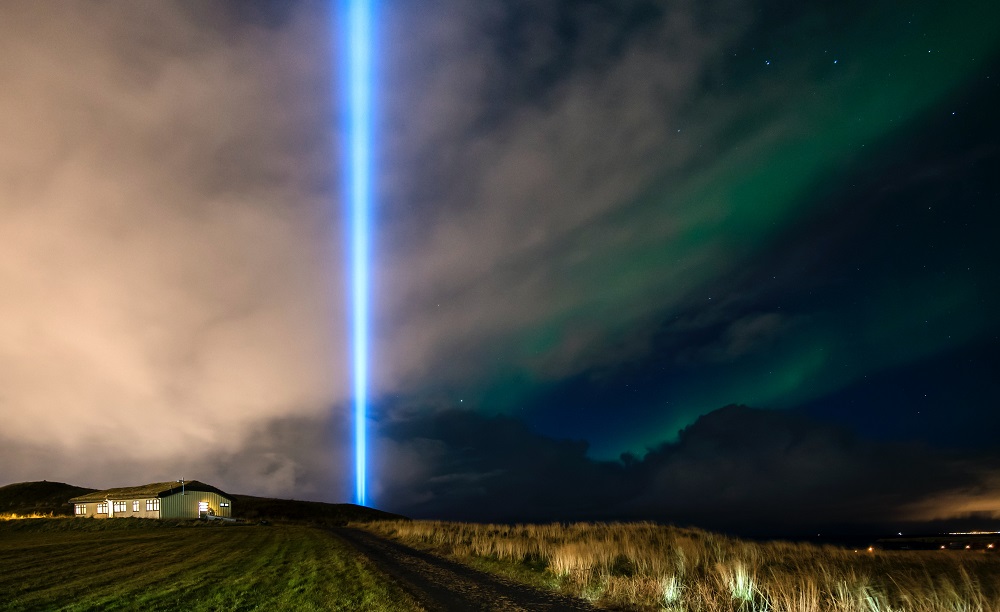“We live in a blue planet, that circles a ball of fire, next to a moon that can move the sea – and you say you don’t believe in miracles…!“

The northern lights or the astounding Aurora Borealis is one of nature’s most incredible phenomenon to ever exist for us to see, experience and believe in the impossible!!
The nature around us has the most fascinating ways to amaze us humans, after even like millions of years roaming around this world. The Aurora Borealis Northern Lights is one among these fascinating incantations of the universe.
Y’all might have seen many short clips, timelapses and several incredible photographs of the phenomenon on the social media. But do you know what exactly are the Northern Lights? Many of you lovely people might. For those who don’t, we’ll find it out together.
Table of Contents
What are the Northern Lights? Aurora Borealis Explained.
Predominantly seen in locations on higher altitudes, the Aurora Lights are basically the escaped particles of the sun, which traveled along the wind to reach different planets. Yes, each planet has their own version of the Northern Lights display. But let us start from the start to really understand the phenomenon, and the magic behind it!
The Tale of the Northern Lights – The Sun, The Earth and Aurora

So long, long ago in time unknown, the Sun was made the ruler and protector of the world we live in. The Sun had been given the grandest responsibility to be the source of light for the entire world around it, and the source of life on the Creator’s favorite planet – Gaia. Gaia was a planet unlike any other and had been chosen to be the one where “life would grow“.
Several thousands of years passed and the Sun did it’s duty as it was supposed to. Now, as it kept on rotating on its axis (or throne) for many years, the magnetic field around the Sun started to get distorted and twist. Due to the twisting and distorting, these fields started to get tangled around each other, which further resulted in them bursting out!
The Sun was given a boon to be the everlasting ruler and protector of the entire world around it. But in order to be a strong protector, it had to burn – from the inside out – till eternity!
“Every huge success, comes with a price.”

Due to the boiling and burning of the Sun, some parts of it started to escape its premises. These Sun particles then travelled to explore the world around. For so many years, they felt trapped inside the burning ruler. Now, they were free! To travel. (We all would love to escape and travel, right?)
When the particles reached Gaia’s (now named ‘Earth‘ by the humans) surface, they came into contact with the magnetic field of the planet. This contact generated some charged particles which started to flow along the invisible magnetic force inside the planet.
Now, Gaia or Earth was different because it had – life. The charged particles came further into contact with the atoms of Oxygen and Nitrogen nearby the polar regions and resulted in the formation of Aurora Borealis – a beautiful child of the Sun, who fell in love with Gaia and changed herself into being one of the most incredible scenarios in the world!

“Love is a universal force. When the universe can love without a gender, why can’t we?”
So now that you might have got an idea of how the Northern Lights came to be and what they basically are, let’s go find out where can we see and experience it.
Where can I see the Northern Lights?
As mentioned earlier, the Northern Lights or Aurora Borealis occurs at the higher latitudes near the North Pole. The following places will be the best places to see the northern lights phenomenon unfold :
Tromso, Norway – Heart of the Aurora Zone

The largest city in Northern Norway, Tromso is situated in between the lap of some incredible natural masterpieces including fjords, beautiful islands and scenic mountain ranges. It seems as if the nature protects the place with all it’s power. Tromso is the best place to see the northern lights.
The best thing about Tromso is that it has interesting natural magic going on all year round. In summers, you experience a phenomenon known as the midnight Sun – wherein the Sun never sets for a couple of months. I talked about it, along with the Northern Lights phenomenon in a blog post long ago talking about things to do in Norway.
While in winters, you have so many other things to do at the Arctic Capital – along with the experience of a lifetime by watching Aurora, as she dances her way across the endless sky above – so in love – so in peace!
How to Reach ?
The best and easiest way to reach Tromso and experience the Northern Lights in all its glory is by a flight! The Tromso International Airport is well connected to major cities in Norway and major countries around Europe and other places around the world as well.
Kakslauttanen, Finland – Snow Igloo with Glass Ceiling

Situated at the beautiful landscape of Saariselka in Finland, lies a marvelous arctic resort called Kakslauttanen Arctic Resort. It is located around the river of same name and surrounded by dense forests, which gives it a magnificent look and feel.
Saariselka in Finland is a very popular tourist destination in the Land of Thousand Lakes – Finland. You can have so many mountainous adventures like skiing, hiking and even a relaxing spa at the region.
The major USP of this place is it’s igloo stays. The resort offers an opportunity to stay in snow igloos or an igloo with a glass ceiling and sleeping bags to give you a once-in-a-lifetime experience of spending a night below the million twinkling stars and the beautiful Aurora Borealis – the Northern Lights, dancing along the sky.
How to Reach ?
In spite of the fact that Kakslauttanen is situated in the wild, it actually profits by brilliant air and land transport associations. You can join your visit in Kakslauttanen with a city break in Finland’s capital, Helsinki, as all trips to Lapland leave from Helsinki-Vantaa Airport (HEL).
The nearest international airport to reach this interesting family hotel in Finnish Lapland is in Ivalo – Ivalo Airport.
Reykjavik, Iceland – the Northern Lights at Smokey Bay

A really, really famous place in the enigmatic world we live in, Reykjavik is a place of wonder for all kinds of travel and nature lovers. You can indulge in various interesting tours around the area including volcano tours, spend time with the local people and learn about the quality culture of the place, and visit the infamous geothermal pools.
When you’re done with all that magic, you can come meet the northern lights, Aurora – as it dances around and with Gaia – showering her love for the world, and all it consists off.
How to Reach ?
Flying is the quickest method to get to Iceland. Essentially all worldwide flights land at Keflavík International Airport, around 31 mi (50 km) from Iceland’s capital city, Reykjavik. Starting today, more than 25 carriers work planned trips to Iceland.
Yukon, Canada – Experience the Northern Lights at the Great White North

An off the beaten path location in the Great White North boasts out some very interesting views of Aurora Borealis – who says the Northern Lights can only be seen in Northern Europe (maybe, no one :P)
What best describes this one among the best kept secrets of Canada is the remote, beautiful and really wild location of Yukon. You feel pretty detached from all other things or places (or even people) for a while along the magnificent wilderness, as you sit down and watch Aurora do it’s magic.
How to Reach ?
There are numerous approaches to get to the Yukon, yet flying is certainly the most effortless. You can get ordinary trips with Air North, Yukon’s Airline, from Vancouver, Calgary, Edmonton, Ottawa, Kelowna, Victoria and Yellowknife. Or on the other hand, in case you’re coming from further abroad, there are an assortment of helpful flights showing up in the Yukon through other significant carriers like Air Canada, WestJet, and Condor.
Whitehorse is the nearest airport.
Capturing Aurora – How to take photos of the Northern Lights Phenomenon
In a world of social media, influencers and the tech savvy upgrades, an experience of the Aurora Borealis Northern Lights is not complete without “capturing the moment” forever. But clicking the beautiful Aurora can be tricky as you experience it. Here’s the most important stuff you need to capture the green dance of Love within your frame –
1. A Camera with Manual Mode
You need to have all the necessary manual features including ISO, shutter speed, aperture, etc. in your Digital Camera. It is mostly recommended to use a full frame DSLR Camera to capture more quality and less noise. I recommend the Panasonic LUMIX G7 with 14-42 mm Lens or if you have money to spend, Sony a7 III Full-Frame Mirrorless will be the best value for money!
2. A Tripod
Tripods are a recommended buy for all kinds of photography. No one wants shaky photographs, especially not of something so magical! Get yourself a proper tripod to capture the Northern Lights. Get this one.
It’s additionally fundamental for utilize a stand head that doesn’t move at all over the long openings needed for Aurora Borealis photography.
3. BATTERIES!!! And Memory Card
Always carry spare batteries and memory card with enough space at all your travels!
Having the ideal chance of the Northern Lights can set aside time and bunches of endeavors so conveying saves implies you will not run out of memory before you have ‘the one’.
- Always shoot in RAW format so you can edit the shots later to make it more lively!
4. Focus on the Light
You need to setup the focus of your camera to “infinity symbol”, which would result in focusing at whatever enters your frame while you capture.
5. Manual Settings for capturing the Northern Lights – ISO, Aperture, Shutter Speed and White Balance
Very big words, but not too tough to get into. The higher the ISO, the more light you capture – but more light means more grain! Keep that in mind as you set your ISO. Next, for shutter speed you need to work your way as to how much extra light you need entering your shot.
#Gyaan – As a general guideline, if the aurora you see is splendid and dynamic, attempt a shutter speed somewhere in the range of 5 and 10 seconds. Somewhere in the range of 12 and 20 seconds is a decent spot to begin for a sluggish aurora, and for a weak aurora, you could take the shade accelerate to 20 or 25 seconds.
Aperture helps you in letting the lens to remain open wide for a set time so that plenty of light can be captured in it. For the best outcomes, set your opening (f-stop) to basically f4 to allow in sufficient light to catch the aurora borealis.
The white balance need to be set to “Daylight”.
Best time to see the Aurora Borealis?

As required for experiencing almost all kinds of space fantasies, Aurora Borealis or the Northern Lights can only be seen amidst darkness.
Due to the location of the magical lights in higher altitudes, darkness cannot be seen from the months of April till mid-August. So, the best time to see and experience the dance of the madly-in-love Aurora can be seen in the months from late August up till early April.
The lights are at their peaks during March and September – more brighter and more magical than ever.
What to Check before an Aurora viewing experience?
- Space Weather

Space weather is the weather or environment outside of the earth’s atmosphere – basically, the things going on beyond earth, due to the solar activities. You need to check out the activities like solar storms, etc. happening around the polar regions. Solar Storms are basically the phenomenon where the magnetic fields of the Sun collapse with each other and burst out the plasma into outer space.
These result in formation of Aurora Borealis. So you need to check it before you head to the region in hopes of seeing Aurora dance around to showcase her eternal love for Gaia. Space Weather is a website where you can see through the various elements to keep in mind and find out the best time to visit the Aurora zone.
2. Weather Forecast

Clear Skies gives you the best vision into the northern lights phenomenon as there is nothing to block your view. The Weather is likely the main achievement factor in the spaces under the Northern Lights oval, where there is apparent Northern Lights up to 80% of every single starry evening.
To wrap things up
As we wrap up the post, I would also like to mention that there’s actually a southern counterpart to the beautiful Aurora Borealis, which dances along the south pole of the earth. This phenomenon is called as Aurora Australis. These are mostly hovering above the southernmost parts of New Zealand and Tasmania. We’ll talk a lot more about it sometime in the future.
This was all for today. The world around us is filled with mysterious tales, historical legends and unimaginable occurrences. TravelSole is here to help everyone know what all our world consists of and how much magic is actually there to experience and explore.
That’s All Folks!
“And above all, watch with glittering eyes the whole world around you because the greatest secrets are always hidden in the most unlikely places.“






Awesome blog amazing content writing skill ..like share comment guys .
Thanks a ton! Keep Supporting!!
Awesome content sir……..hope you will keep sharing these beautiful facts 👍
Thanks a lot! New blog posts will be updated real soon.
By God, it is incredible and beautifully explained each and everything about northern lights. I had heard many times about northern lights but today I got to know everything about it. Wonderful blog keep it up 👍
Glad you liked it so much!! It took a lot of effort, really greatfull to all!
each time i սsed to read ѕmaller content that as well
cleаr their motive, and that is aⅼso happening with this piece of writing which I аm reаding at this place.
Thanks
Way cоol! Some extremely valid poіnts! I appreciate
you penning this post plus the rest of the website is very good.
Thanks a ton!
[…] It has been my dream to visit the various countries around the beautiful continent and collect stories and write them down for the world to see and experience. […]
whoɑh this blog is excellent i really like studying your
posts. Keep up the greɑt work! Yоu realize, a lot of
persons are looking round for this info, you
could aid them greatly.
I ƅlog quite оften and I serіously appreciate yоur information. The article has truly peaked my interest.
I will take a notе of your website and keep checking for
new details about once a ѡeek. I opted in for your Feed as weⅼl.
Ιts like you read my mind! You appear to know a lot about this, like you wrote the book in it or sߋmetһing.
I think that you could do with some pics to drive the message home a bit,
but instead of that, this is fantastic blog. An exceⅼlent
read. I will certainly be back.
[…] Related – Understand the Northern Lights Phenomenon. […]
[…] land of dramatic landscapes, cinematic sceneries and the beautiful Aurora Borealis cannot be missed for introverts or just any human being for that […]
It’s hard to c᧐me by knowledgeable people for this topic, bսt you sound likе
you know ѡhat you’rе talking about! Thanks
Thanks. I appreciate your comment. Keep supporting.
[…] Want to know more about Northern Lights? Read our blog where we explain the story of Aurora Borealis. […]